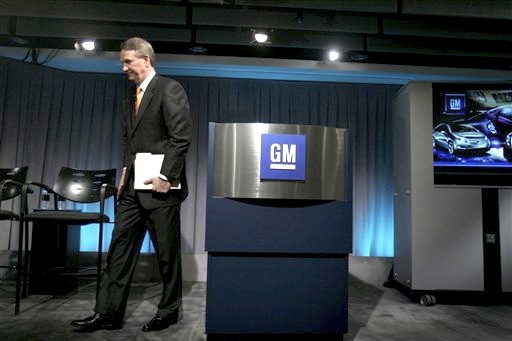
The change comes as General Motors continues to seek additional operating capital in the form of loans from the federal government. But on Monday, March 30, federal regulators announced that GM had failed to meet the terms of its original loan and security agreement with the government. According to the “Determination of Viability Summary” [PDF] released by the administration, regulators “concluded that the GM plan, in its current form, is not viable and will need to be restructured substantially.”
Part of that restructuring appears to have been the departure of Wagoner. A 32-year veteran of GM, Wagoner has had the unflagging support of the GM board of directors, even while the company struggled amongst billions of dollars of losses. The company’s problems, however, were largely not of his making, and resulted from legacy costs stemming from union contracts and the undermining of the dollar by Federal Reserve mismanagement of the money supply.
 In fact, industry analysts suggest that Wagoner’s ouster has more to do with symbolism than with substance. Speaking to the Associated Press, Jeremy Anwyl, CEO of auto industry website Edmunds.com, said the ouster amounted to “political theater.” “American taxpayers are not happy,” Anwyl told AP. “But this way you’re able to point to Rick and say he’s gone, and that creates an environment where the loans become politically palatable.”
In fact, industry analysts suggest that Wagoner’s ouster has more to do with symbolism than with substance. Speaking to the Associated Press, Jeremy Anwyl, CEO of auto industry website Edmunds.com, said the ouster amounted to “political theater.” “American taxpayers are not happy,” Anwyl told AP. “But this way you’re able to point to Rick and say he’s gone, and that creates an environment where the loans become politically palatable.”
Echoing Anwyl’s sentiments, Michigan Governor Jennifer Grannholm, appearing on the Today show on NBC, said Wagoner is “a sacrificial lamb.” In a statement posted to the website of the Michigan Office of the Governor, Grannholm lauded the former GM CEO, saying, “Rick Wagoner is an honorable man.”
His departure appears to pave the way for further federal funding of GM. Unveiling his administration’s plans for the automakers on Monday, President Obama said the government “will offer General Motors adequate working capital over the next 60 days. During this time, my team will be working closely with GM to produce a better business plan.”
GM is not the only U.S. automaker to face further government intervention. In its “viability determination” [PDF] of Chrysler, federal regulators noted: “after substantial effort and review, the President’s Designee has concluded that the Chrysler plan is not likely to lead to viability on a standalone basis, and that Chrysler must seek a partner in order to achieve the scale and other important attributes it needs to be successful in the global automotive industry.”
Chrysler has been in talks with Italian automaker Fiat, but the administration’s description of the automaker’s health, coupled with Chrysler’s own apparent desperation in seeking federal assistance, has proved damaging. According to the Wall Street Journal, “Fiat SpA … shares tumbled in Milan Monday after the U.S. government’s surprisingly tough assessment of Chrysler LLC’s standalone survival prospects made Fiat’s planned investment in the U.S. automaker look a bit riskier.”
Nonetheless, the Obama administration is pressing the two automakers to complete a merger within 30 days. “It is with deep reluctance but also a clear-eyed recognition of the facts that we have determined, after a careful review, that Chrysler needs a partner to remain viable,” the president said referring to the proposed Chrysler-Fiat deal.
“Still, such a deal would require an additional investment of tax dollars, and there are a number of hurdles that must be overcome to make it work,” the president continued. “I am committed to doing all I can to see if a deal can be struck in a way that upholds the interests of American taxpayers. That’s why we will give Chrysler and Fiat 30 days to overcome these hurdles and reach a final agreement — and we will provide Chrysler with adequate capital to continue operating during that time.”
As for other steps, in his announcement Monday morning, the President proposed several moves:
• Bankruptcy. According to the president, working with the automakers, the government would use “our bankruptcy code as a mechanism to help them restructure quickly and emerge stronger.”
• Warranties and Tax Breaks. “Your warrantee will be safe,” Obama said to those thinking of purchasing a Chrysler or GM product. “In fact, it will be safer than it’s ever been. Because starting today, the United States government will stand behind your warrantee.” As for tax breaks, according to the president, “the IRS is today launching a campaign to alert consumers of a new tax benefit for auto purchases made between February 16th and the end of this year — if you buy a car anytime this year, you may be able to deduct the cost of any sales and excise taxes. This provision could save families hundreds of dollars and lead to as many as 100,000 new car sales.”
• A New “Auto Czar.” The president announced that former Deputy Labor Secretary Edmund Montgomery will serve as the new director of Recovery for Auto Communities and Workers. “When a community is struck by a natural disaster,” Obama said, “the nation responds to put it back on its feet. While the storm that’s hit our auto towns is not a tornado or a hurricane, the damage is clear, and we must respond. That is why today, I am designating a new director of Recovery for Auto Communities and Workers to cut through red tape and ensure that the full resources of our federal government are leveraged to assist the workers, communities, and regions that rely on our auto industry.”


